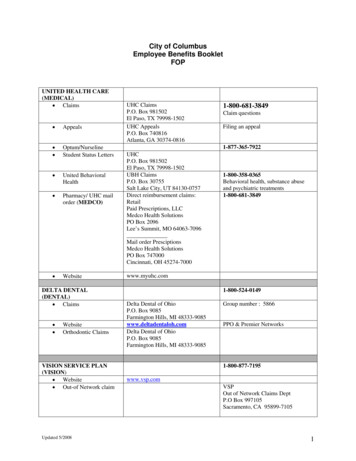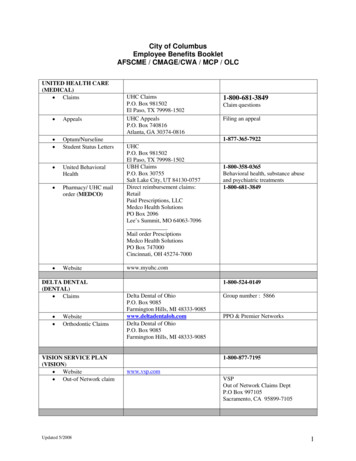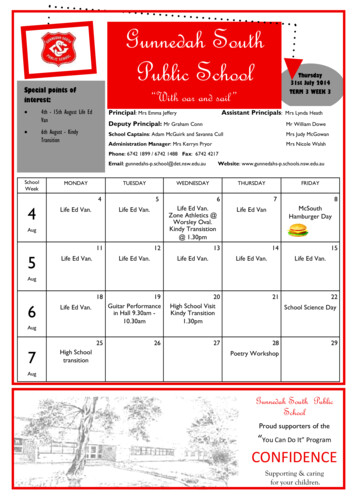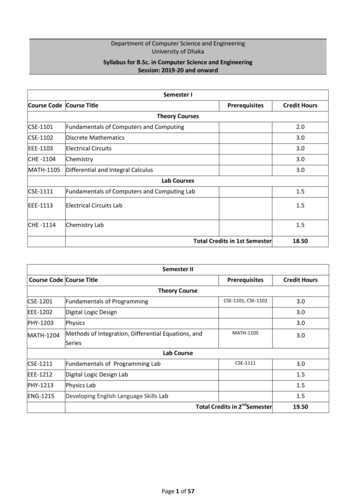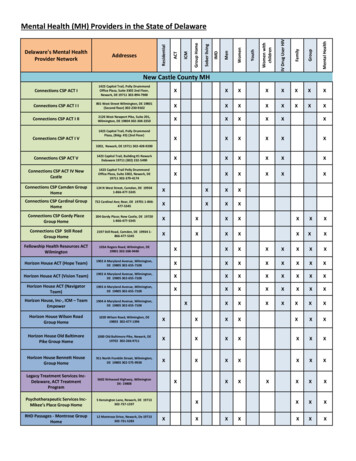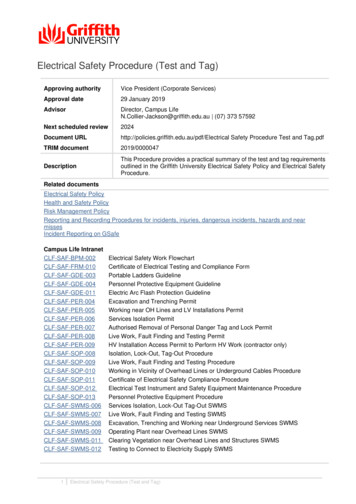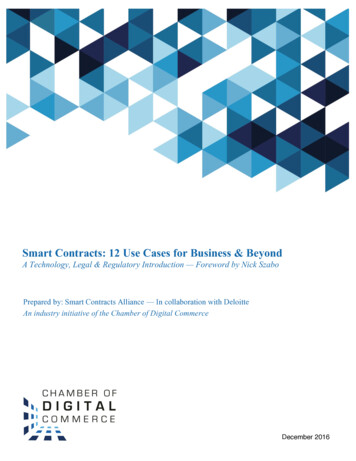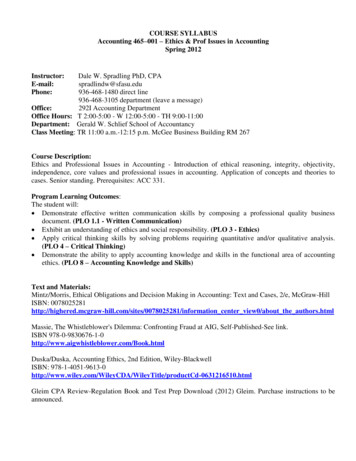
Transcription
Adult Basic EducationScienceScience 3105From Life to LifestyleStudy GuideCredit Value:1Prerequisites:NoneText:science.connect1; Colbourne, Fernandez, et al; McGraw-HillRyerson; 2002.Science Courses [General College Profile]Science 2100AScience 2100BScience 2100CScience 3101Science 3102Science 3103Science 3104Science 3105Science 3106
Table of ContentsTo the Student . . . . . . . . . . . . . . . . . . . . . . . . . . . . . . . . . . . . . . . . . . . . . . . . . . . . . . . . . . . . . . . . vIntroduction to Science 3105 . . . . . . . . . . . . . . . . . . . . . . . . . . . . . . . . . . . . . . . . . . . . . . vUse of Science Study Guides . . . . . . . . . . . . . . . . . . . . . . . . . . . . . . . . . . . . . . . . . . . . . . viRecommended Evaluation . . . . . . . . . . . . . . . . . . . . . . . . . . . . . . . . . . . . . . . . . . . . . . . viiUnit 1 - Plant and Animal Cells . . . . . . . . . . . . . . . . . . . . . . . . . . . . . . . . . . . . . . . . . . . . . . Page 1Unit 2 - Life Functions . . . . . . . . . . . . . . . . . . . . . . . . . . . . . . . . . . . . . . . . . . . . . . . . . . . . . Page 5Unit 3 - Nutrition . . . . . . . . . . . . . . . . . . . . . . . . . . . . . . . . . . . . . . . . . . . . . . . . . . . . . . . . . Page 8Unit 4 - Maintaining Homeostasis . . . . . . . . . . . . . . . . . . . . . . . . . . . . . . . . . . . . . . . . . . Page 12Appendix . . . . . . . . . . . . . . . . . . . . . . . . . . . . . . . . . . . . . . . . . . . . . . . . . . . . . . . . . . . . . . Page 15
To the StudentI.Introduction to Science 3105Science 3105, From Life to Lifestyle, is the first of two courses at this level that covers LifeScience topics. You begin by learning about microscopes and how they are used. You areintroduced to the basic structures and functions of cells and the life functions common to livingthings. You will progress to an understanding of the importance of nutrition and lifestyle inhelping your body carry out life functions and maintain homeostasis.You should have your instructor check your written work when you complete the Study Guidequestions for each unit. You should also submit any lab reports and assignments that arerequired for the course. Check with your instructor to see if there is any other work that needs tobe passed in.The text for this course is science.connect1; Colbourne, Fernandez, et al; McGraw-Hill Ryerson;2002.Study GuidevScience 3105
To the StudentII.Use of Science Study GuidesBefore beginning this course, ensure you have the text and any other resources needed (see theinformation in the Introduction to this course for specifics). As you work through the StudyGuide, you will see that it is divided according to the Units listed in the Table of Contents.When you open a unit it will have the following components:Reading for this Unit:Here you will find the chapters, sections and pages of the text you will use to cover the material for this unit. Skimthe sections of the textbook, look at the titles of the sections, scan the figures and read any material in the margins.Once you have this overview of the unit, you are ready to begin. Do not be intimidated by the content. You willwork through the text, section by section, gaining knowledge and understanding of the material as you go.References and NotesWork to SubmitThis left hand column guides you through thematerial to read from the text. Read anyhighlighted notes that follow the readinginstructions. The symbols direct you tothe questions that you should complete whenfinished a reading assignment.You come across three (4) headings in this right hand column.Writing:This section comprises your notes for the unit. Here you willfind either written questions or references to specific questionsor problems from your text. You may want to write out eachquestion followed by the answer. This material should bechecked by your instructor before moving on to the next unit.Mathematical problems should have their solutions checked asyou go.Laboratory:This section indicates if there is a Core Lab that should becompleted for the unit. Let the instructor know in advance thatyou will be ready for the lab. A lab report should be submittedfor each Core Lab. Your instructor will provide guidelines as tohow s/he wants the report written.Assignment:This section indicates if there is an assignment that should becompleted for the Unit. The information in the “References andNotes” column will indicate how you obtain the assignment.These assignments frequently relate the science content totechnology, society and the environment.Computer:This section indicates that you will use a computer and a printerto complete some of the required work for the course. Ask yourinstructor for help if you are not sure how to use the computer.You will be required to print out some material each time youdo the computer work and the printouts should be included withthe written notes.Study GuideviScience 3105
To the StudentIII.Recommended EvaluationWritten NotesLabs/AssignmentsTest(s)Final Exam (entire course)10%20%20%50%100%The overall pass mark for the course is 50%.Study GuideviiScience 3105
Unit 1 - Plant and Animal CellsTo fulfill the objectives of this unit, students should complete the following:Reading for this unit:science.connect1; Chapter 8, pages 156 - 177.References and NotesWork to SubmitStudy pages 158 - 159 and usethe glossary if you like to answerquestions 1.1 - 1.2. Writing:Study the parts and functions ofa compound microscope onpages 160 - 161. Then answerquestions 1.3 and 1.4. 1.1What is a microscope and what is it used for?1.2a) What is the difference between a compoundmicroscope and an electron microscope?b) Which of these types is used in most schoolstoday?1.3Complete the diagram of the microscope inAppendix A.1.4Copy and complete the following chart:Microscope PartFunctionLight sourceDiaphragmStageStage ClipsObjective LensTubeEye PieceCourse AdjustmentKnobFine Adjustment KnobArm and BaseStudy GuidePage 1Science 3105
Unit 1 - Plant and Animal CellsReferences and NotesLoad the CD-ROM into yourcomputer, launch theMicroscope lesson and followthe instructions to work yourway through it. Complete 1.5. Work to SubmitComputer:1.5Note: If you don’t have acomputer, see your instructor fordirections for the Computersections in this Study Guide.Study the information in the boxon page 163. Then answerquestion 1.6. Study pages 164 - 165 and usethe glossary, if you like, toanswer questions 1.7 - 1.10. Study GuidePrint out the Microscope Parts Printout and theCertificate (with your name on it). Include thesewith your notes.Writing:1.6Copy and complete the following chart:Magnificationof EyepieceMagnificationof nWrite a definition for each of the following:- cell- organelle- tissue- organ- organ system- organismPage 2Science 3105
Unit 1 - Plant and Animal CellsReferences and NotesWork to Submit1.8 Make a table with 2 columns.In the first column, list the levels of organizationin living organisms beginning with cells.In the second column, give an example of eachlevel1.9Define theory.1.10State the three hypotheses of the cell theory.1.11Describe the role of the following cellularstructures:(i)cell membrane(ii)cytoplasm(iii) nucleus(iv)endoplasmic reticulum(v)mitochondrion(vi)chloroplast(vii) vacuole(viii) golgi body(ix)cell wall1.12Which of the structures listed in question 1.11 isfound only in plant cells?1.13Label the diagrams of the plant and animal cellsfound in Appendix A.Study pages 166 - 167 and usethe glossary, if you like, toanswer questions 1.11 - 1.13. Note: You may want to get extracopies of the diagrams from yourinstructor for practice.Study GuidePage 3Science 3105
Unit 1 - Plant and Animal CellsReferences and NotesWork to SubmitLaboratory:Note: Before you start the Investigation, you should getcopies of the handouts, Preparing a Wet Mount Slide andMaking a Stained Slide, from your instructor and workthrough them. Check with your instructor to see if there isanything that you need to pass in for doing this work.Refer to Investigation 8-B, PlantCell Organelles, pages 168 - 170to do the laboratory. 1.14Complete Investigation 8-B. Pass your LabReport in to your instructor for marking.Note: See your instructor to findout what needs to be included inyour Lab Report.This is the end of Unit 1. Seeyour instructor to see if there isany more work that you need todo for this unit.Study GuidePage 4Science 3105
Unit 2 - Life FunctionsTo fulfill the objectives for this unit, students should complete the following:Reading for this unit:Chapter 9, page 178 - 195.References and NotesWork to SubmitWriting:Study pages 180 - 182. Thenanswer questions 2.1 - 2.3. Note: Life functions can also becalled life processes.2.1Define life functions.2.2Name the seven life processes common to livingthings.2.3a) What does it mean when we say cells andtissues are specialized?b) Give 2 examples of a specialized plant oranimal system.Study pages 183 - 185. Thenanswer questions 2.4 - 2.7. 2.4a) Where do animals get energy?b) How do plants get energy?Note: Plants and animals needenergy to carry out their lifefunctions.2.5a) Define photosynthesis.b) Name the organelle where photosynthesis takesplace.c) Copy and complete the following chemicalequation for the process of photosynthesis:carbon dioxide glucose Study GuidePage 5Science 3105
Unit 2 - Life FunctionsReferences and NotesWork to SubmitWriting:2.6a) Define cellular respiration.b) Name the organelle where cellular respirationtakes place.c) Write the chemical equation for the process ofcellular respiration.2.7Load the CD-ROM into yourcomputer, launch thePhotosynthesis lesson andfollow the instructions to workyour way through it. Complete2.8. Computer:2.8Study pages 186 - 189. Thenanswer questions 2.9 - 2.14. Draw a clearly labeled diagram to show howphotosynthesis and cellular respiration work in acycle.Print your Certificate (with your name on it) at theend of the exercises. Include the certificate withyour notes.Writing:2.9Describe the functions of the following humanorgan systems: digestive system, circulatorysystem, urinary system and nervous system.2.10Complete the following flow chart to show thepath that food travels through the digestive tract:mouth 6Study Guide6Page 66666anusScience 3105
Unit 2 - Life FunctionsReferences and NotesWork to SubmitWriting:Note: You will need to refer tothe Digestive System handout inAppendix A to help with question2.11.2.11a) Describe the function of the following parts ofthe human digestive system: salivary glands,esophagus, stomach, small intestine, largeintestine, rectum, anus.b) Label the diagram of the digestive system onthe Digestive System handout, found in AppendixA.2.12a) Describe the function of the following parts ofthe human circulatory system: heart, arteries,veins, capillaries.b) Label the diagram in the handout, The BloodRoute, found in Appendix A.Study pages 190 - 191. Thenanswer question 2.15. 2.13Explain how the circulatory system works.2.14Explain how the circulatory system and thedigestive system work together2.15Describe the role of each of the following indiagnosing injury and/or disease: blood pressurecuff, stethoscope, X ray, CAT scan, EKG, EEG.This is the end of Unit 2. Seeyour instructor to see if there isany more work that you need todo for this unit.Study GuidePage 7Science 3105
Unit 3 - NutritionTo fulfill the objectives of this unit, students should complete the following:Reading for this unit:Chapter 10, pages 196 - 213.References and NotesWork to SubmitWriting:Study pages 196 - 200. Thenanswer questions 3.1 - 3.3. 3.1Define nutrition and nutrient.3.2a) Define malnutrition.b) Describe the effects of malnutrition.3.3Copy and complete the following table:NutrientStudy GuidePage 8Function(s)FoodSource(s)Science 3105
Unit 3 - NutritionReferences and NotesWork to SubmitRefer to Investigation 10 -A,Testing for Nutrients, pages201 - 203 to do the laboratory.Laboratory: 3.4Complete Investigation 10-A. Pass your LabReport in to your instructor for marking.Note: See your instructor to findout what needs to be included inyour Lab Report.Writing:Study pages 204 - 206. Thenanswer questions 3.5 - 3.9. 3.5Define diet.3.6Name the four food groups classified in Canada’sFood Guide.3.7Describe the five guidelines of Canada’s FoodGuide.3.8What categories of information do nutrition labelsprovide?3.9Complete the activity, Comparing Food Labels,on page 205. Use the Handout in the Appendix torecord your information.3.10Name and briefly describe the three processesinvolved in digestion.3.11Define enzyme.Study pages 207 - 209. Thenanswer questions 3.10 - 3.15. Study GuidePage 9Science 3105
Unit 3 - NutritionReferences and NotesWork to SubmitWriting:Load the CD-ROM into yourcomputer, launch the Digestionlesson and follow theinstructions to work your waythrough it. Complete 3.16. 3.12Describe the digestive process (both mechanicaland chemical) that happens in the mouth.3.13Describe the digestive process (both mechanicaland chemical) that happens in the stomach.3.14Describe the chemical digestion of carbohydrates,protein and fat in the small intestine.3.15a) Where does most absorption of nutrientsoccur?b) In which other organ does absorption ofnutrients occur?Computer:3.16Print your Certificate at the end of the exercises(with your name on it). Include the certificate withyour notes.Assignment:Refer to page 210 to complete3.17 in the assignment. (The assignment consists of questions 3.17 and 3.18.)3.17Note: You will need to keep arecord of everything that you eatfor one full day before you startthe assignment. Include thiswith your assignment.Study GuideComplete Investigation 10-B, Analyze Your Diet,page 210.Note: Use the Handout, Data Collection Sheet: FoodRecord, included in the Appendix.Page 10Science 3105
Unit 3 - NutritionReferences and NotesWork to SubmitAssignment: (continued)Use Canada’s Food Guide tocomplete 3.18 in the assignment. 3.18Plan a well balanced diet for yourself for 1 day.Explain your choices.Note: Pass the completedassignment in to your instructorfor marking.This is the end of Unit 3. Seeyour instructor to see if there isany more work that you need todo for this unit.Study GuidePage 11Science 3105
Unit 4 - Maintaining HomeostasisTo fulfil the objectives of this unit, students should complete the following:Reading for this unit:Chapter 11, pages 214 - 233.References and NotesWork to SubmitWriting:Study pages 216 - 217. Thenanswer questions 4.1 - 4.2. 4.1Define homeostasis.4.2Describe how the body tries to maintainhomeostasis for each of the following:a) enzyme levelsb) waste product levelsc) blood sugar leveld) concentration of substances in bloode) heart ratef) water balanceStudy pages 221 - 222. Thenanswer questions 4.3. 4.3Classify each factor listed in Fig.11.6 as beingrelated to lifestyle, diet, genetics, or a combinationof these.Study pages 225 - 227. Thenanswer question 4.4. 4.4For each of the following diseases or disorders;diabetes, ulcers, anorexia nervosa, bulimianervosa, heart attack:i)indicate whether the cause is related to lifestyle,diet, genetics, or a combination of theseii)give a brief description of the disease/disorderiii)possible treatments for the disease/disorderNote:Factors that interfere withthe balance of body systems canbe categorized into three areas,lifestyle, diet and genetics.Study GuidePage 12Science 3105
Unit 4 - Maintaining HomeostasisReferences and NotesWork to SubmitWriting:Study pages 228 - 229. Thenanswer questions 4.5 - 4.7. 4.5a) Why would someone need kidney dialysis?b) Briefly explain how kidney dialysis worksSee your instructor to get a copyof the Technology Challengeexercise to do 4.8. 4.6Describe the following forms of technology, andthe conditions they are used to treat:angiogrampacemaker4.7What is a colonoscopy and what is it used todiagnose?4.8Complete the Technology Challenge exercise.This is the end of Unit 4. Seeyour instructor to see if there isany more work that you need todo for this unit.Study GuidePage 13Science 3105
Appendix
The MicroscopeName:Date:Use the terms below to label the parts of the microscope. Check each part of the microscope that has a blank line attached.Label the microscope by printing the correct name of the part on the line.armfine-adjustment knobstagebasehigh-power objective lensstage clipscoarse-adjustment knoblight-sourcetubediaphragmlow-power objective lenseye piecerevolving nosepiece
Plant CellName:Date:
Animal CellName:Date:
Comparing Food LabelsName:Date:Use this chart to organize your information for Find Out Activity: Comparing Food hydratesVitaminsMineralsDaily ValueFood Label 1Food Label 2Food Label 3
Data Collection Sheet: Food RecordName:Date:Use this worksheet to record the foods you ate. Classify each item as a grain product, vegetable or fruit, meat or meat alternative, or milkproduct.Record the number of servings you ate of each item.Record the number of calories of each item.Total the number of servings and the number of calories you ate from each food group.Total the calories from all your food groups. FoodGrain ProductsVegetables & FruitMeat &AlternativeProductsMilk 0Example: AppleCaloriesCaloriesTotalsRecommendedNumber of Servings5 - 125 - 102-3Total Number of Calories:2-4Calories
Digestive ProcessesName:Date:Study the diagram and label the parts, using the list below.mouth - where food enters body; contains teeth and salivary glandsteeth - chew food into smaller pieces for swallowingsalivary glands - moisten food with enzymes that begin chemical breakdownesophagus - pushes food to stomach through wave-like muscle spasmsstomach - muscles contract to mix food; releases acids that activate chemicals to digest food;dissolves food into liquid formsmall intestine - has chemicals to digest food; neutralizes stomach acid; absorbs 80 to 90percent of nutrientslarge intestine - absorbs vitamins, minerals and watergall bladder - stores bilepancreas - provides much digestive enzymes; produces insulin to extract nutrients from foodrectum - stores solid waste (undigested food)anus - discharges solid mass of undigested food called feces
The Blood RouteName:What to Do:Trace the route that blood takes on itsjourney through the body. Colour thearteries red, to represent the oxygenatedblood they carry. Colour the veins blue, torepresent the deoxygenated blood theycarry.Although the lungs are considered part ofthe respiratory system, they play a crucialrole in the circulatory system. Withoutlungs, the blood circulating through yourbody would have no way of replenishing itsoxygen supply or getting rid of waste gases processes that are vital for survival. Thecirculatory system relied on the lungs to“refresh” the blood. Without this constantrefreshment, the blood in this closedtransport system would soon be toxic,delivering more harm than good to thebody’s cells.How exactly do your lungs work? They aremade up of millions of small air chambersDate:Pay special attention to the heart and lungs remember that these organs contain bothoxygenated and deoxygenated blood. Howcould you best represent this on thediagram?called alveoli. Alveoli have a large surfacearea to allow for maximum gas exchange. Avast network of tiny blood vessels surroundsthe alveoli, and it is across the membranesof these blood vessels that oxygen andcarbon dioxide are exchanged.Then, as you know, the oxygen is carried bythe blood to the cells of your tissues, whilethe carbon dioxide is carried by the bloodaway from the cells, back to your lungs.When you exhale, the carbon dioxide travelsfrom the lungs out through your nose andmouth and is released into the environment.
Science Courses [General College Profile] Science 2100A Science 2100B Science 2100C Science 3101 Science 3102 Science 3103 Science 3104 Science 3105 Science 3106. Table of Contents . Colbourne, Fernandez, et al; McGraw-Hill Ryerson; 2002. To the Student Study Guide Science 3105vi II. Use of Science Study Guides
